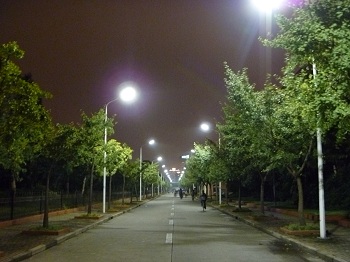
A road with LED streetlamp glare on which the researchers validated their lab findings. Source: Yandan Lin
Even as the use of LED streetlights will provide significant energy savings to municipalities and the public, it could also bring something a bit less desirable: increased glare in drivers’ eyes that could prove uncomfortable at best, unsafe at worst. A research team from China and the Netherlands has now quantitatively modeled the impact of “discomfort glare” from LED streetlights, and provided a set of practical parameters for planners to tweak in the lighting’s placement and design (Opt. Express, DOI: 10.1364/OE.22.018056).
The greater glare potential of LED lamps derives from some of their differences from conventional bulbs. For example, the LED varieties emit similar amounts of light from a smaller area, and also carry a larger energy component in the blue part of the spectrum, which humans tend to perceive as especially bright.
To determine how LED streetlight designs might adapt to reduce the glare for drivers, the research team, drawn from Fudan University in China, and from Philips Research scientists in China and the Netherlands, deconstructed the glare potential of a given LED source into four adjustable parameters. Those variables were the source’s average luminescence, the background luminescence, the solid angle of the source from the viewer’s perspective (a proxy for the source’s apparent size to the viewer), and the angle between the viewer’s line of sight and the source.
The team then set up a lab to simulate driving conditions on a dark road, and adjusted the four model parameters to create 72 separate lighting conditions. They asked 12 test subjects in the lab to rate the lighting using the deBoer rating scale, a nine-point scale that ranks perceived glare from “unnoticeable” to “unbearable.” Using the data and regression analysis, the team was able to infer an equation relating the deBoer rating of a given LED light source to the four parameters. They found that by far the most important variable that would increase discomfort glare was “illuminance at the eye”—a product relation between the source luminance and the solid angle—with background luminance and line-of-sight angle playing somewhat less important roles.
While the researchers continue to investigate potential improvements to the model, they believe it should be immediately useful to designers, planners and construction firms working on the installation and placement of LED streetlights.
